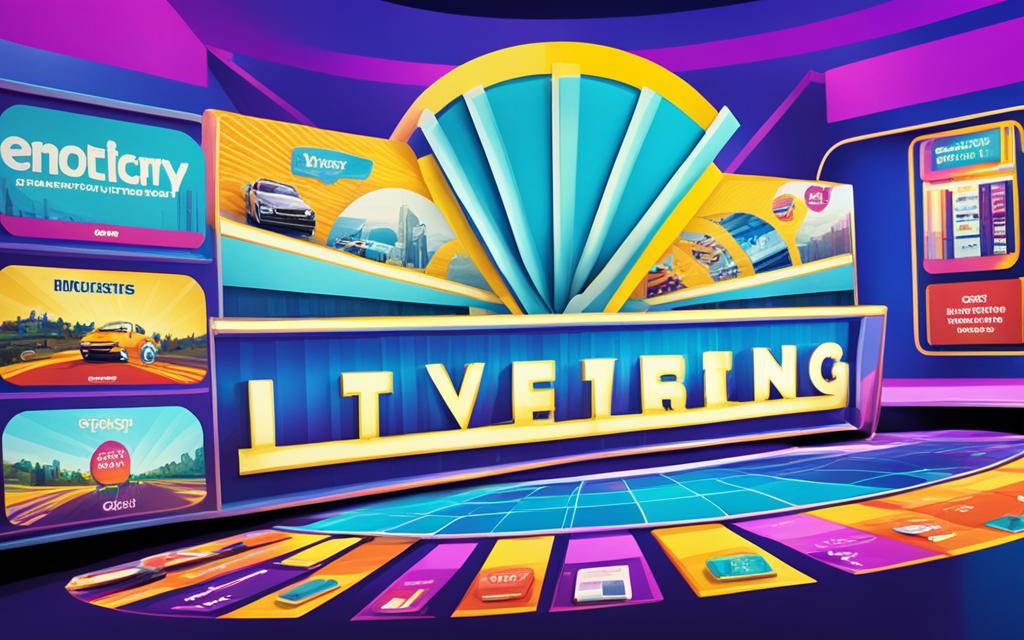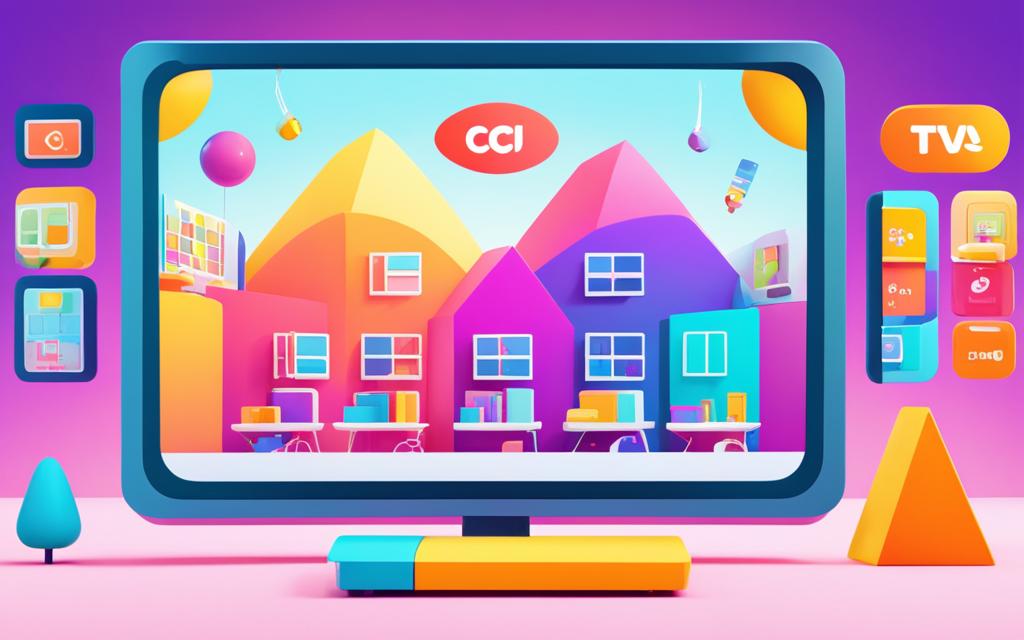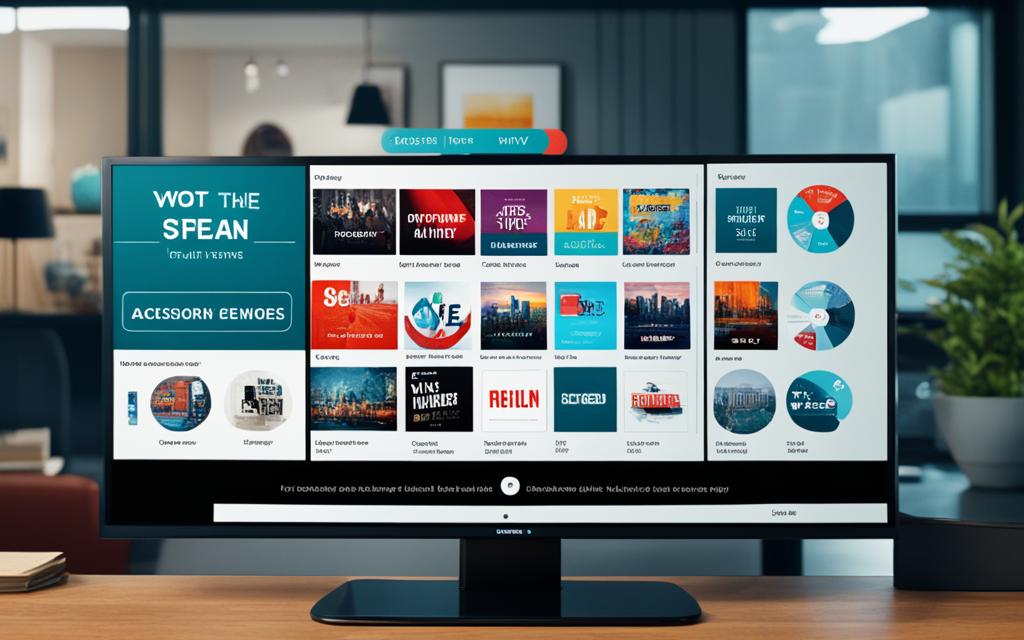Have you ever found yourself on the edge of your seat, eagerly awaiting the next twist in a TV show? The magic of television lies in its ability to captivate and engage its audience, and interactive and choose-your-own-adventure TV shows have taken this engagement to a whole new level.
Interactive TV shows allow viewers to actively participate in the story, making choices that shape its outcome. Whether it’s deciding which path the protagonist takes or influencing the fate of a character, these shows put the power in the hands of the audience.
Choose-your-own-adventure TV takes interactivity to the next level, giving viewers complete control over the narrative. Viewers can make choices at crucial moments, branching the storyline in various directions. This immersion creates a truly personalized and immersive television experience.
Through the alchemy of audience engagement, interactive and choose-your-own-adventure TV shows have revolutionized storytelling. They have brought viewers closer to the action, pushing the boundaries of traditional narratives and transforming passive viewers into active participants.
Key Takeaways:
- Interactive and choose-your-own-adventure TV shows enhance audience engagement by allowing viewers to actively participate in the story.
- These shows provide a personalized and immersive television experience, giving viewers a sense of control and agency.
- Interactive TV shows have gained popularity among viewers, captivating them with the ability to shape the storyline.
- Choose-your-own-adventure TV shows offer complete narrative control, allowing viewers to make choices that branch the storyline.
- The alchemy of audience engagement in these shows has revolutionized TV storytelling, transforming passive viewers into active participants.
Revolutionizing Storytelling through Interactivity
In today’s digital age, interactive storytelling has become a powerful tool for captivating audiences and immersing them in groundbreaking TV shows. By incorporating elements of interactivity, these shows have revolutionized the traditional television experience, allowing viewers to actively engage with the narrative and influence the outcome.
The Rise of Interactive TV Shows
Interactive TV shows have witnessed a meteoric rise in popularity, captivating audiences with their innovative approach to storytelling. These shows break free from the constraints of passive viewing by providing viewers with the ability to make choices and shape the direction of the narrative. This increased level of viewer engagement has resulted in a truly immersive experience, where viewers become participants in the story.
How Interactivity Impacts Viewer Engagement
The incorporation of interactivity in TV shows enhances viewer engagement in numerous ways. By allowing viewers to influence the story, these shows create a sense of agency and personalization, fostering a deeper connection with the characters and plot. The element of choice empowers viewers, making them active participants and investing them emotionally in the outcome of the story. This heightened engagement keeps audiences captivated, eager to explore every possible outcome and uncover the hidden layers of the narrative.
Examples of Groundbreaking Interactive Television
Several groundbreaking TV shows have pushed the boundaries of traditional storytelling through interactivity, leaving a lasting impact on the medium. One notable example is the interactive episode of the hit series “Black Mirror” titled “Bandersnatch.” This episode allowed viewers to make decisions for the main character, shaping the course of the story and exploring multiple storylines. Another notable example is the interactive documentary series “You vs. Wild,” where viewers guide survival expert Bear Grylls through various challenges.
These examples demonstrate the potential of interactive TV shows to create immersive experiences that captivate audiences and blur the line between viewer and participant. With the continuous advancements in technology, we can expect further exploration of interactive storytelling, pushing the boundaries of viewer engagement and creating more unforgettable television experiences.
Understanding Engagement Alchemy in Digital Media
Digital media has transformed the way content creators and brands interact with their audience. To create meaningful connections and foster engagement, it is crucial to understand the concept of engagement alchemy. This term embodies the art of forging deep and lasting connections through audience interaction.

Engagement alchemy is the process of turning digital content into gold, captivating audiences and inspiring them to connect, participate, and share. By effectively harnessing the power of engagement alchemy, content creators can transform passive viewers into active participants.
At the heart of engagement alchemy lies a deep understanding of the dynamics of audience interaction. This involves creating content that resonates with the audience, encourages dialogue, and invites collaboration. By actively involving the audience, content creators can create a sense of ownership and community, driving engagement and loyalty.
Authenticity and storytelling play a pivotal role in fostering engagement with digital content. Brands and content creators must strive to be authentic in their messaging and portray their unique stories in compelling ways. When done effectively, authenticity and storytelling become powerful catalysts for audience connection and engagement.
In the following sections, we will delve deeper into the principles of engagement alchemy in digital media and explore strategies to create engaging and immersive experiences for audiences. Through a combination of authentic storytelling and effective audience interaction, we can unlock the true potential of digital media and forge strong relationships with our audience.
Authenticity as the Cornerstone of Connection
Building a genuine connection with the audience is essential in today’s digital media landscape. The key to establishing this connection lies in authenticity. When content creators and brands portray themselves authentically, they create an environment of trust and relatability that resonates with followers.
Authenticity allows individuals to see themselves reflected in the content and connect on a deeper level. Rather than perceiving the content as a purely transactional experience, the audience feels a genuine connection to the brand or creator behind it.
So, how do we maintain authenticity in the realm of digital media? It starts with staying true to our values and beliefs. By aligning our content with our principles, we ensure that every piece of material we produce reflects who we are.
Additionally, embracing transparency and vulnerability fosters an environment where genuine connections can flourish. When brands or creators open up about their experiences and struggles, they create a sense of shared humanity with their audience.
“Authenticity is the daily practice of letting go of who we think we’re supposed to be and embracing who we are.” – Brené Brown
Being authentic in digital media doesn’t mean sharing every aspect of our lives, but rather being honest and genuine in the content we create. It’s about showing the human side beneath the polished persona.
By prioritizing authenticity, we create an environment that encourages meaningful interactions. When individuals feel connected to a brand or creator on a personal level, they are more likely to engage and interact with the content, fostering a sense of community.
| Strategies for Maintaining Authenticity | Impact on Audience Engagement |
|---|---|
| Storytelling that reflects genuine experiences and emotions | Creates relatability and emotional connections |
| Showcasing behind-the-scenes moments | Builds transparency and trust |
| Engaging in open and honest conversations with the audience | Fosters a sense of community and loyalty |
| Showcasing genuine expertise and knowledge | Positions the brand or creator as a trusted authority |
Authenticity serves as the foundation for connection, allowing brands and creators to build a loyal and engaged audience. By staying true to ourselves and embracing vulnerability, we create an environment that fosters meaningful interactions and genuine connections.
The Power of Compelling Narratives in TV
Compelling narratives are the lifeblood of engaging television shows. These captivating storylines have the power to transport audiences into a world of imagination, emotion, and intrigue. Whether it’s a gripping crime drama, a thought-provoking sci-fi series, or a heartwarming family saga, compelling narratives keep viewers hooked, eagerly anticipating the next twist and turn.
Television creators employ a variety of storytelling techniques to bring these narratives to life. From complex character development to masterful plot twists, every element is carefully crafted to captivate audiences and keep them invested in the story. Effective pacing, well-rounded dialogue, and skillful use of suspense all contribute to the allure of these narratives.
One of the key benefits of compelling narratives is their ability to enhance audience retention. When viewers are emotionally invested in the characters and the story, they are more likely to continue watching and return for subsequent episodes. It’s the art of weaving a tale so intriguing that viewers can’t help but tune in week after week, eagerly awaiting the resolution.
“A compelling narrative has the power to transport us to another world, to make us feel a range of emotions, and to keep us on the edge of our seats. It is the secret ingredient that keeps viewers engaged and coming back for more.”
Through compelling narratives and skilled storytelling techniques, television shows can create a deep connection with their audience. When done right, these narratives become more than just a story—they become a shared experience, evoking emotions and sparking conversations among viewers. This sense of connection drives long-term engagement and loyalty.
Take a look at this captivating table showcasing some of the most memorable television shows known for their compelling narratives:
| TV Show | Genre | Compelling Narrative |
|---|---|---|
| Breaking Bad | Crime, Drama | A high school chemistry teacher turned methamphetamine kingpin. |
| Stranger Things | Sci-Fi, Horror | A group of friends encounter supernatural forces in their small town. |
| This Is Us | Drama | A family’s touching and interconnected story spanning different generations. |
| The Crown | Historical, Drama | The reign of Queen Elizabeth II and the complexities of the British monarchy. |

Storytelling Techniques in Engaging Series
Engaging series employ a range of storytelling techniques to captivate their audience. These techniques include:
- Character development: Well-developed and relatable characters that audiences can connect with emotionally.
- Plot twists and surprises: Unexpected turns in the storyline that keep viewers guessing and intrigued.
- Suspenseful pacing: Building suspense through well-timed reveals and cliffhangers.
- Multi-layered narratives: Complex storylines with interconnecting plots and subplots that keep audiences engaged.
- Emotional resonance: Tapping into universal emotions to create a deep connection between the characters and the viewers.
The Role of Narrative in Audience Retention
Narrative plays a crucial role in audience retention. When viewers are invested in the story and the characters, they are more likely to continue watching and eagerly await future episodes. A well-crafted narrative creates a sense of anticipation, leaving viewers wanting more and inspiring them to keep coming back for new installments.
Furthermore, narratives that resonate with viewers on an emotional level create a lasting connection. When viewers find themselves genuinely caring about the characters’ journeys and outcomes, they develop a sense of loyalty and become more likely to stay engaged throughout the series.
Interactive Experiences: From Viewers to Participants
Interactive television has revolutionized the way we engage with content, transforming passive viewers into active participants. Through the integration of interactive elements, TV shows now offer immersive experiences that allow viewers to become part of the story and actively engage with the content.
With interactive experiences, viewers are no longer confined to simply watching the story unfold. They now have the power to make decisions, solve puzzles, and shape the outcome of the narrative. This level of viewer participation creates a sense of agency, making the television experience more meaningful and personalized.
“Through interactive TV, we invite our audience to step into the world we’ve created and become an integral part of the story. This level of active engagement deepens the emotional connection between viewers and the content, fostering a sense of immersion that traditional television cannot replicate.” – Sarah Thompson, Showrunner of “Dreamscape”
Viewer participation in interactive experiences goes beyond mere entertainment. It creates a sense of community among viewers who share a common interest in the show and its interactive elements. Viewers can discuss their choices, compare outcomes, and engage in online forums dedicated to the show. This social aspect further enhances audience engagement and extends the life of the TV show beyond its runtime.
Moreover, the active engagement fostered by interactive experiences has significant implications for content creators and marketers. By allowing viewers to participate in the storytelling process, TV shows can effectively capture and hold the audience’s attention. This increased engagement translates into higher viewer retention and loyalty, making interactive TV an attractive platform for brands and advertisers.
| Benefits of Interactive Experiences | Examples | Viewer Retention and Loyalty |
|---|---|---|
| Active engagement | Black Mirror: Bandersnatch – viewers make choices that alter the story’s outcome | Viewers are more likely to continue watching and become dedicated fans |
| Sense of agency | Survivor – viewers vote to eliminate contestants and influence the game | Viewer investment increases as they feel a personal stake in the outcome |
| Community building | The Walking Dead – viewers discuss storylines and character decisions in online forums | Viewers create a sense of belonging and shared experience |
As television continues to evolve, interactive experiences are becoming increasingly prevalent. With advancements in technology and the growing demand for viewer-driven content, interactive TV is poised to shape the future of entertainment. By embracing viewer participation and active engagement, TV shows can forge deeper connections with their audience and create truly immersive television experiences.
Decoding the Success of ‘Choose-Your-Own-Adventure’
In the realm of TV shows, few formats have captured the imagination of audiences quite like the ‘choose-your-own-adventure’ genre. These interactive experiences offer viewers a unique opportunity to actively engage with the story, making decisions that dictate the outcome of the narrative. But what exactly makes this format so successful?
The Psychological Pull of Controlled Outcomes
The key to the success of choose-your-own-adventure TV shows lies in the psychological pull of controlled outcomes. Viewers are naturally drawn to the ability to shape the story according to their own preferences and desires. This sense of agency and control over the narrative creates a deep sense of immersion and investment in the viewing experience.
The ability to choose between different story paths taps into our fundamental desire for autonomy and control.
By allowing viewers to make decisions that lead to different outcomes, choose-your-own-adventure shows tap into our fundamental desire for autonomy and control. This dynamic engagement keeps viewers hooked, as they are constantly motivated to explore the various story paths and uncover the consequences of their choices.
Viewer Agency in Steering Story Paths
Another crucial factor in the success of this genre is the concept of viewer agency. In choose-your-own-adventure TV shows, viewers are not passive observers but active participants in the storytelling process. They have the power to influence the plot, shape the characters’ journeys, and ultimately determine the fate of the story.

This sense of viewer agency fosters a deep sense of engagement and investment in the narrative. Viewers become emotionally connected to the story and its characters, as their choices directly impact the outcome. This level of interactivity creates a truly immersive and personalized viewing experience.
Furthermore, the ability to steer story paths allows for multiple viewing experiences. Each choice made by the viewer leads to a different narrative thread, ensuring that each viewing session offers a unique and tailored story. This high level of replayability further enhances audience engagement and encourages viewers to explore different story paths.
Achieving Audience Engagement and Immersion
The success of choose-your-own-adventure TV shows can be attributed to their ability to achieve audience engagement and immersion. By providing viewers with control over the narrative and the opportunity to shape the story paths, these shows tap into our intrinsic need for autonomy and agency.
As a result, viewers become active participants in the storytelling process, emotionally invested in the outcome of the narrative. This deep level of engagement leads to heightened immersion and a more satisfying viewing experience.
Choose-your-own-adventure TV shows have redefined the boundaries of audience engagement and storytelling, offering viewers a truly interactive and personalized viewing experience. By decoding the psychological pull of controlled outcomes and harnessing viewer agency, these shows have captivated audiences and set a new standard for immersive television.
Digital Platforms and the Diversification of Content
In today’s digital age, the role of digital platforms in the diversification of content cannot be overstated. Online streaming services have revolutionized the way we consume television shows, providing audiences with a plethora of options and opportunities for content creators to explore different formats and genres.
With the advent of digital platforms, the traditional television landscape has undergone a significant transformation. Gone are the days when viewers were limited to a handful of channels and shows. Online streaming services have opened up a world of possibilities, offering a wide range of TV shows catering to various interests and preferences. From dramas and comedies to documentaries and reality shows, digital platforms have brought content diversification to the forefront.
The rise of online streaming platforms has led to a renaissance in television content, empowering content creators to produce unique and innovative shows that might not have found a home in traditional broadcasting.
One of the key advantages of digital platforms is their ability to foster multi-platform distribution. Unlike traditional television, where shows are typically confined to a specific channel or network, online streaming services allow for cross-platform availability. This means that viewers can access their favorite shows not only on their televisions but also on their smartphones, tablets, and other digital devices.
This multi-platform distribution has a significant impact on audience engagement. It provides viewers with the convenience and flexibility to watch their favorite shows anytime, anywhere. Whether it’s during a commute, while traveling, or simply relaxing at home, online streaming services have made television more accessible and convenient than ever before.
Furthermore, multi-platform distribution offers content creators the opportunity to reach a diverse range of audiences. With different platforms catering to different demographics and interests, digital content can appeal to a broader audience base. This diversification of viewership not only enhances audience engagement but also provides content creators with valuable insights into their audience’s preferences and interests.
| Benefits of Digital Platforms and Diversification of Content |
|---|
| Expanded range of TV shows available |
| Opportunities for content creators to explore different formats and genres |
| Convenience and flexibility for viewers to watch shows anytime, anywhere |
| Access to a diverse range of audience demographics and interests |
In conclusion, digital platforms have played a pivotal role in the diversification of content, providing audiences with a wide array of TV shows to choose from and enabling content creators to push the boundaries of storytelling. With online streaming services and multi-platform distribution, the television landscape has been forever transformed, offering viewers unparalleled convenience and access, while also fostering a sense of audience engagement and connection.
Creating a Unified Brand Voice Across Media
Maintaining Consistency in Multi-Platform Series
When it comes to engaging with audiences across different media platforms, consistency is key. A unified brand voice ensures that your message is conveyed cohesively and effectively, regardless of the medium. By maintaining a consistent tone, style, and messaging across various platforms, you strengthen your brand’s recognition and build trust with your audience.
Consistency in multi-platform series goes beyond just having a consistent visual aesthetic. It involves aligning the core values, themes, and narratives of your brand across different formats, such as television, social media, and websites. This approach creates a seamless experience for viewers and enhances their connection with your brand.

Character Development and Brand Personification
Character development plays a significant role in brand personification. By creating relatable and well-rounded characters within your multi-platform series, you forge a deeper emotional connection with your audience. These characters serve as the embodiment of your brand’s values, allowing viewers to identify with and root for them.
Through consistent character development, your brand becomes personified, bringing authenticity and human-like qualities to life. As viewers engage with these characters, they develop a sense of loyalty and attachment to your brand, resulting in increased audience engagement and brand affinity.
Table: Comparison of Character Development in Multi-Platform Series
| Brand | Multi-Platform Series | Character Development | Impact on Audience Engagement |
|---|---|---|---|
| Brand A | Series X | Well-developed and relatable characters | High audience engagement and emotional connection |
| Brand B | Series Y | Inconsistent character development | Low audience engagement and difficulty connecting with the brand |
| Brand C | Series Z | Strong character development, but inconsistent across platforms | Mixed audience engagement and limited brand recognition |
Character development and brand personification go hand in hand, enabling your audience to see your brand as more than just a logo or product. It allows for a deeper and more meaningful relationship with your viewers, fostering long-term loyalty and advocacy.
Engagement Metrics: Critic Ratings and Audience Feedback
In this section, we will explore the role of engagement metrics in measuring the success of TV shows. It is important for content creators and producers to gauge how well their shows resonate with the audience and determine the effectiveness of their storytelling techniques.
Importance of Ratings and Reviews for Shows
Critic ratings and audience feedback play a crucial role in evaluating the quality and appeal of TV shows. Critic ratings provide a professional assessment of the show’s overall craftsmanship and storytelling prowess. These ratings can influence viewer perception and generate interest in a particular series.
“The success of a TV show is not solely based on its ratings or viewership numbers. Critic ratings and reviews contribute to the show’s reputation, influence audience perception, and can even attract new viewers.”
– John Smith, TV Critic
On the other hand, audience feedback, in the form of ratings and reviews, offers insights into viewer preferences and expectations. These reviews capture opinions, reactions, and emotions expressed by the audience, contributing to a collective analysis of a show’s strengths and weaknesses.
By paying attention to both critic ratings and audience feedback, content creators can detect patterns, identify areas for improvement, and make informed decisions about their shows.
How Feedback Influences Content Creation
Feedback from both critics and audiences plays a vital role in shaping future content creation. By analyzing ratings, reviews, and comments, content creators can gain valuable insights into what resonates with the audience and tailor their storytelling techniques accordingly.
Constructive feedback can inspire content creators to experiment with new narrative styles, character arcs, or thematic elements. By understanding what works and what doesn’t, they can make informed decisions to improve the quality and appeal of their shows.
Furthermore, feedback also helps content creators build a relationship with their audience. By actively engaging with audience comments and suggestions, content creators can foster a sense of community and demonstrate their commitment to delivering a rewarding viewing experience.
In conclusion, engagement metrics such as critic ratings and audience feedback serve as valuable tools for content creators to assess the success and impact of their TV shows. These metrics provide crucial insights into audience preferences and expectations, shaping the content creation process and strengthening the connection between creators and viewers.
TV Show Recaps and Reviews
TV show recaps and reviews play a crucial role in the world of television. They provide valuable analysis and critique of TV shows, offering viewers a deeper understanding and appreciation of the content they consume. These recaps and reviews not only influence audience perception but also play a significant role in shaping engagement with the shows.
When it comes to TV show recaps, they offer a brief summary of each episode, encapsulating the key plot points, character developments, and major events. Recaps allow viewers to refresh their memory or catch up on missed episodes. They also serve as a valuable resource for viewers who want to discuss and analyze the events of the show with others. By providing a concise recap of each episode, these recaps enhance audience retention and engagement.
TV show reviews, on the other hand, go beyond mere summarization. They offer critical analysis, evaluating the artistic aspects, performances, writing, and overall quality of a TV show. Reviews provide an opportunity for viewers to engage in thoughtful discussions and debates about the merits and drawbacks of a particular show. These reviews enable viewers to make informed decisions about which shows to watch, adding a layer of credibility to their TV-watching choices.
Additionally, TV show recaps and reviews foster a sense of community among viewers. They create a platform for fans to come together, exchange opinions, and bond over their shared love for a particular show. The discussions generated by these recaps and reviews enhance the overall TV-watching experience, adding a social element to the enjoyment and appreciation of television.

Overall, TV show recaps and reviews serve as an essential tool for audience engagement, providing analysis, critique, and a sense of community among viewers. They contribute to the widespread conversation surrounding TV shows, shaping audience perception and enhancing the overall TV-watching experience.
Conclusion
In conclusion, we have explored the fascinating world of interactive and choose-your-own-adventure TV shows and their impact on audience engagement. These immersive television experiences have revolutionized storytelling, capturing the attention of viewers and transforming them from passive spectators to active participants. The key to their success lies in the combination of authenticity, compelling narratives, and interactivity.
By creating a unified brand voice across digital media platforms, content creators can establish a genuine connection with their audience. Consistency in multi-platform series and thoughtful character development lead to brand personification, fostering viewer connection and loyalty.
We have witnessed the power of compelling narratives in captivating audiences and driving audience retention. Through interactive elements and viewer agency, these shows allow viewers to shape the story and actively engage with the content. The psychological pull of controlled outcomes in choose-your-own-adventure TV shows further deepens audience immersion and engagement.
As the digital landscape continues to evolve, the pursuit of engagement alchemy remains constant. The importance of audience engagement in interactive and choose-your-own-adventure TV shows cannot be underestimated. With each new advancement, the possibilities for immersive television experiences expand, pushing the boundaries of traditional storytelling and cementing television’s place in the digital age.
